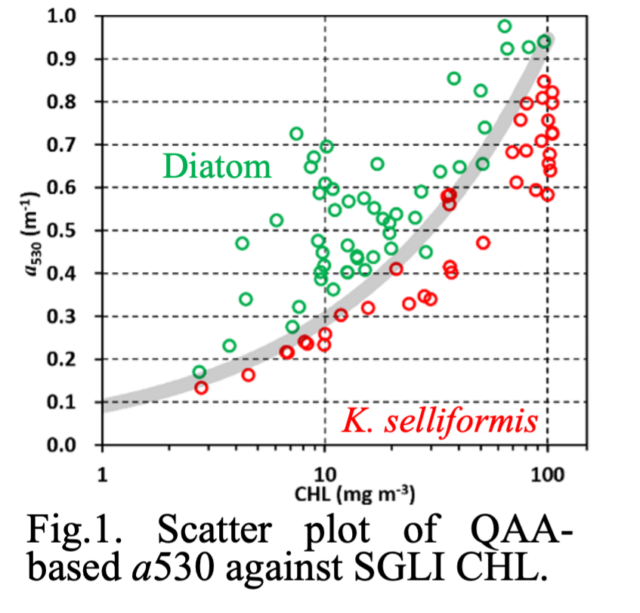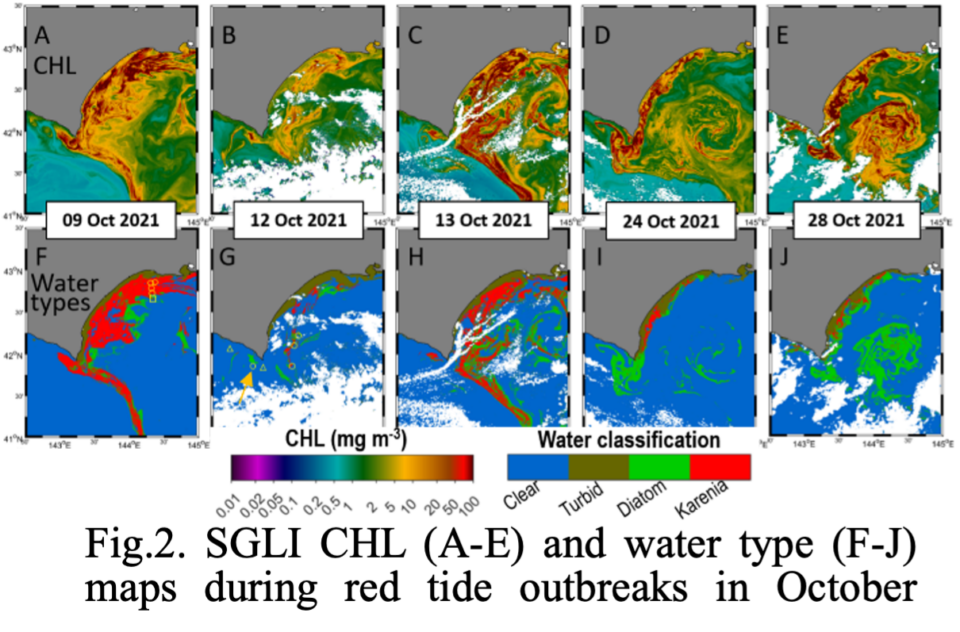GCOM-C/SGLI-based water optical properties during fall 2021 red tide outbreak off southeast Hokkaido (group B02)
the present writer: Eko Siswanto
An unprecedented and devastating outbreak of a red tide, also known as a harmful algal bloom, caused by phytoplankton Karenia selliformis occurred during the fall 2021 in the waters off southeast Hokkaido. The red tide resulted in extensive mortality of salmon and sea urchins and caused economic losses totaling $67 million to the local fishery industry.
To anticipate and mitigate the impacts of red tide outbreaks in the future, a satellite observation-based near real-time monitoring system (NRT) is thus required. However, understanding the optical properties of the waters during red tide outbreaks is a prerequisite to developing the red tide detection algorithms that will be implemented into the NRT which is currently being developed by JAMSTEC.
 Quasy-analytical algorithm (QAA, Lee et al., 2022) was applied to GCOM-C/SGLI remote sensing reflectance (Rrs) to derive total absorption (a) at a wavelength (l) 530 nm (a530). Within the same range of SGLI chlorophyll-a concentration (CHL), the a530 during the K. selliformis red tide tended to be lower than during the bloom of diatom, non-red tide phytoplankton group (Fig. 1). Considering that the a530 during K. selliformis red tide or diatom blooms was mainly attributed to phytoplankton absorption, the lower a530 during K. selliformis bloom was probably associated with lower accessory pigment absorption of K. selliformis than that of diatom (e.g., Bricaud et al., 2004).
Quasy-analytical algorithm (QAA, Lee et al., 2022) was applied to GCOM-C/SGLI remote sensing reflectance (Rrs) to derive total absorption (a) at a wavelength (l) 530 nm (a530). Within the same range of SGLI chlorophyll-a concentration (CHL), the a530 during the K. selliformis red tide tended to be lower than during the bloom of diatom, non-red tide phytoplankton group (Fig. 1). Considering that the a530 during K. selliformis red tide or diatom blooms was mainly attributed to phytoplankton absorption, the lower a530 during K. selliformis bloom was probably associated with lower accessory pigment absorption of K. selliformis than that of diatom (e.g., Bricaud et al., 2004).
Applying the borderline in Fig. 1 (gray line) differentiating K. selliformis bloom waters from diatom bloom waters, as well as adopting Siswanto et al.’s (2013) approach to classify clear waters and turbid waters, the water types during October 2021 red tide outbreaks were mapped (Fig. 2). The coastal and offshore waters are mainly classified as turbid and clear waters, respectively. High CHLs in Fig. 2A-C are classified as the waters of red tide caused by K. selliformis, but high CHLs in Fig. 2D-E are classified as normal blooms by diatom. Such diatom blooms are likely associated with the inputs of nutrients from the ocean subsurface layer accompanied by relatively low sea surface temperature (SST) (e.g., Malviya et al., 2016). The red tide of K. selliformis was likely associated with relatively warm SST, low nutrients, and vertically stratified water column (e.g., Kuroda et al., 2021; Yamaguchi et al., 2022).
Keywords: red tide, remote sensing, GCOM-C/SGLI, Hokkaido

